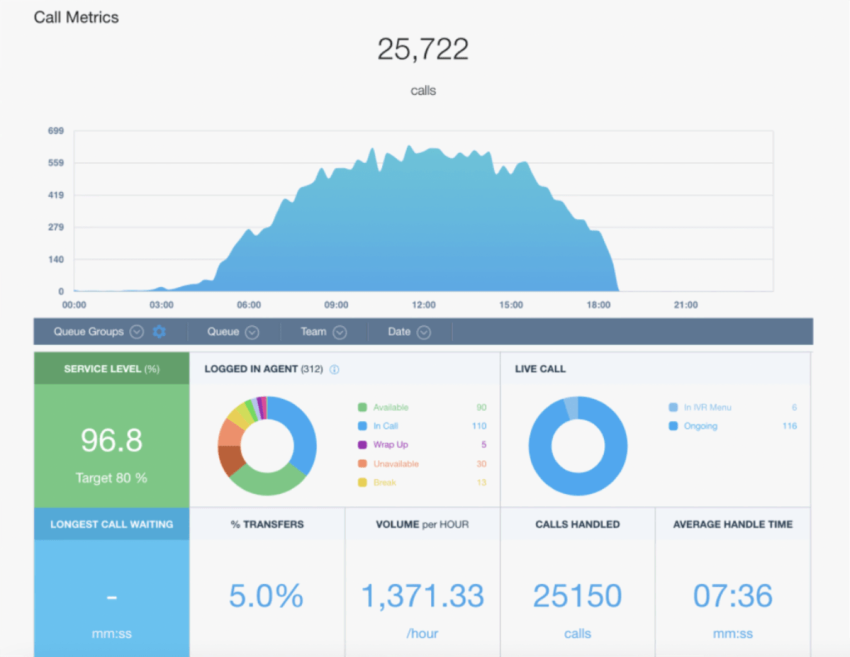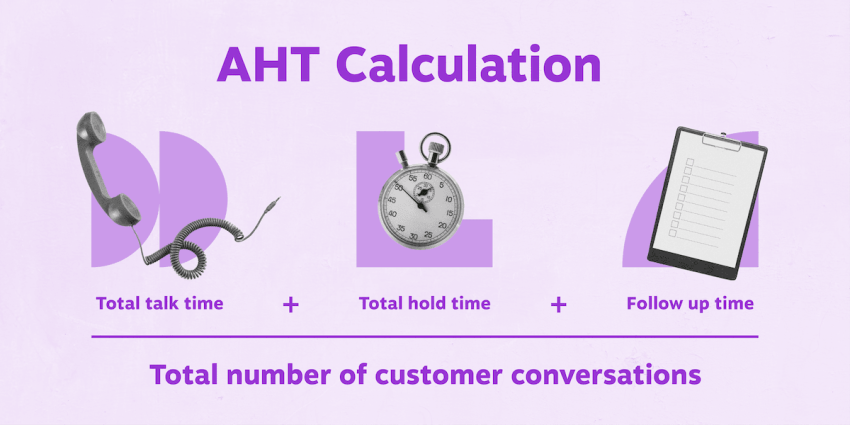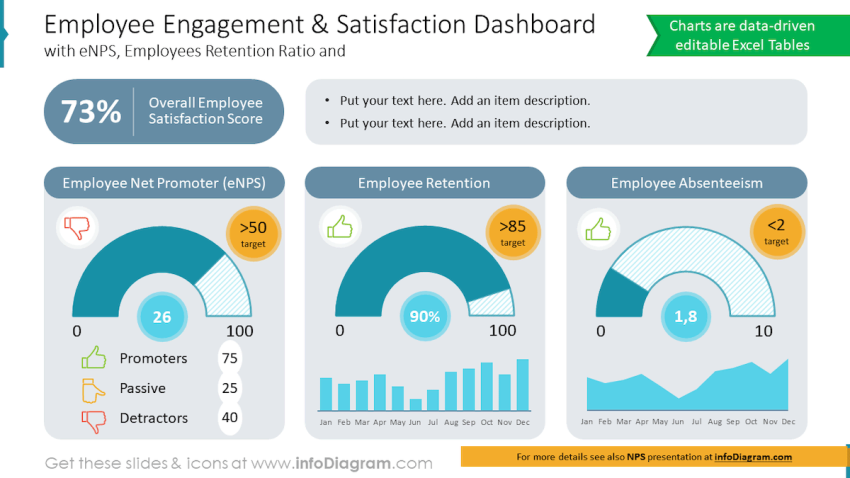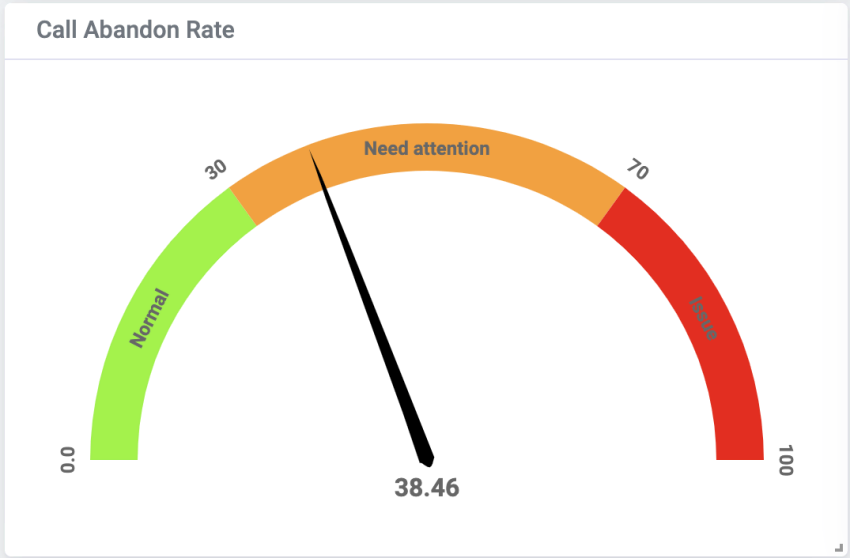If you can’t see what’s happening in your call center, making business decisions like staff forecasting and queue optimization is impossible. It’s a finger-in-the-air process that’s flawed throughout.
That’s where call center dashboards come into play. They provide a visual overview of what is happening, has happened, and is likely to happen. When implemented, dashboards help call centers optimize their call flows, agent assignments, and self-service efforts.
In this guide, we introduce the following:
- What does a call center dashboard consist of?
- Call center dashboard examples
- Best practices when building your call center dashboard
- Dashboarding made simple with Nextiva
What Does a Call Center Dashboard Consist Of?
Call center dashboards have lots of configurable components. In this first section, we walk through four high-level areas and dig into specific reports and metrics.
You can display these as line graphs, bar charts, pie charts, and even heatmaps, depending on your call center technology. You can use all or some of these based on your business needs.
1. Call volume and trends
The most basic report you need on your real-time dashboard is the number of calls. As well as calls received over a period of time, you can filter the following:
- Total calls
- Missed calls
- Answered calls
- Abandoned calls (when a caller hangs up before an agent has answered)
- Channel mix (voice, email, chat, SMS, social media, etc.)
When you receive many calls per day, you have a large pool of data. Within this data, your call analytics software starts to spot call volume trends:

A call center dashboard can report on:
- Hourly trends
- Daily trends
- Weekly trends
- Monthly trends
- Annual trends
- Peak times
- Seasonal fluctuations

When there’s pressure to answer every call within a target time frame, it’s important to set a reachable benchmark.
Running a service level agreement (SLA) compliance dashboard allows you to view the percentage of calls answered within your target time frame.
For example, you answer 80% of calls within 20 seconds, which seems okay. But you also might notice that your average speed to answer is 28 seconds, so you know there must be some anomalies:

Having this data available means you can start to investigate why some calls take so long to get answered.
2. Agent performance
In addition to displaying call volumes and trends on your call center dashboard, you can show specific agent metrics.
Agent availability shows the number of agents logged in, on calls, and idle. Displaying these metrics on real-time wallboards allows supervisors to make decisions about when to free up agents who aren’t needed to take calls right then.
The opposite is also true during times of high call volumes without the right number of agents available to handle what’s coming in.
At the end of the day/week/month, you can get an overview of each agent’s time available versus unavailable, too:

Average handle time (AHT) displays the average time spent on each call. You can use this metric to form a benchmark for junior agents to strive for on completion of their training.

First contact resolution (FCR)reports on the percentage of calls resolved on the first interaction. This is a vital metric to work out whether agents are resolving all your customers’ queries or simply trying to end the call quickly.
This can happen in some call centers when agents are concerned with hitting time-based metrics rather than quality.
Agent satisfaction is a less-used but highly important key performance indicator (KPI) that puts your employees’ experience first. After all, happy employees mean high retention and happy customers.
Scores are collated from internal surveys and availability states to provide a snapshot on how happy your agents are at work:

3. Customer satisfaction
Customer satisfaction is, quite simply, how happy your customers are with the service you provide. You can use several metrics, with data gathered from your customers, to display on your call center dashboard.
A customer satisfaction score (CSAT)is the average rating from customer surveys or feedback forms. Here, you’re directly asking customers questions about their experience with your company over the last quarter/year.
| Note: This metric is different from how happy they are with your product. The questions you include in your survey should be asked accordingly. |
Net promoter score (NPS) is the likelihood of customers recommending your service to others, gathered by asking the literal question:
“Based on your last interaction, how likely are you to recommend our service?”

CSAT and NPS are great metrics to compile over time and include on a KPI dashboard. For a live data view of how your customers are feeling, sentiment analysis provides the overall emotion of customer interactions (positive, negative, or neutral).
You can get a score out of five points for tone, greeting, and call rating. When calls drop below a certain benchmark or specific words are used, calls are automatically flagged to a supervisor.
Where does your CX strategy stand with AI?
Take the AI Maturity assessment to get personalized recommendations on how to enhance your CX.
4. Operational efficiency
Your call volume and agent performance metrics can all be broken down to provide actionable insights.
Call center metrics such as call abandonment rate show the percentage of calls abandoned before being answered:

If you have a high abandonment rate, it means you have lots of customers giving up before you answer their calls. This can lead to unhappy customers in the moment and churn in the long run.
Tracking this metric in real time helps you keep a handle on whether you have enough agents answering inbound calls.
Average hold time is another KPI that impacts customer happiness and helps you judge whether you have enough quantity or quality of agents answering calls.
This metric shows the average time customers spend waiting on hold (it can also compare against your best and worst days):

Resolution rate indicates the percentage of calls resolved within a specific time frame:

Let’s say your target response time is 10 minutes, but agents tend to spend 13 minutes start to finish on calls. Your resolution rate is over by 30%, denoting either a dip in call center productivity or an inflated target time.
Resource utilization includes tracking the efficiency of agent assignments, comparing how long each agent spends logged in or on a call versus time spent on breaks, wrap-up, or training:

You can track all these metrics in real time and historically on your analytics dashboard.
You can also display them on a live wallboard in your office and/or in meetings with supervisors and other stakeholders in your business.
Call Center Dashboard Examples
1. Live wallboard
The purpose of a live wallboard is to present real-time insights to agents and supervisors:

Agents can see how they (or their team) are performing compared to other agents and past call center performances. Using wallboards in this manner inspires gamification and continuous improvement.
A live wallboard gives supervisors a holistic view of day-to-day operational efficiency, alerting them to any abnormal call patterns or customer behaviors.
Common metrics on a live wallboard include:
- Total number of calls today
- Average wait time
- Percent of calls resolved
- Abandonment rate today
- Best-performing agents
- Current agent states
2. Historical call center KPIs and metrics
A performance dashboard with historical reports is often used by supervisors and managers to make business decisions like agent recruitment and call queue configuration.
You can also dig into factors such as drops in CSAT and call resolution to work out whether agents need more training.
Common historical metrics include:
- First-call resolution rate
- Comparison of daily calls per month
- Trends in CSAT
- Spikes and drops in call resolution
- Average handle time
- Average time on hold

3. Channel mix
If you’re an omnichannel contact center rather than a phone-based call center, tracking how your channels are used is vital to proving your return on investment.
For example, if you spend extra to enable email and SMS but none of your customers use them, it’s hard to justify the expense.
Likewise, if all your customers use email and social media, it’s time to train more agents so you can meet your customers on their channel of choice.
You can even see which channels are active right now. If the majority of your customer interactions are happening via phone, free up social media agents to handle incoming calls.

Be it live or historical, call center monitoring and management are aided through the introduction of a contact center dashboard.
Evaluating contact centers? Get the buyer’s guide.
This guide reveals the five pillars of a modern platform, key questions to ask, and red flags to avoid.
Best Practices When Building Your Call Center Dashboard
It’s one thing to turn on your dashboard. It’s another to start using it and driving serious business value. Abide by these best practices to make the most of your investment.
Customization
While most call center software comes with preconfigured templates, aligning what you see with your unique business requirements is key.
- Use role-based dashboards with specific layouts and metrics for supervisors, agents, and managers to cater to different user needs.
- Select the KPIs that mean the most to you, choosing from a library of predefined metrics or creating custom metrics.
- Apply branding to match your company identity and use themes and colors to highlight specific departments, reports, or users.
- Connect with other business systems (CRM, ticketing, etc.) for a holistic view of how call metrics impact wider business KPIs like ticket closure rate and sales conversion.
Real-time updates
When something goes wrong, you need to know about it right away. Failure to act fast can sometimes mean losing a customer.
Configure the following to stay ahead of the curve:
- Streaming updates: Continuously refresh data for immediate monitoring of call volume, agent status, and customer sentiment.
- Dashboard refresh intervals: Set custom refresh rates to balance data accuracy with efficiency.
- Live agent activity: Track individual agent call handling in real time for coaching and support.
Filtering and drill-down
With call center features like auto attendant, interactive voice response (IVR), and CRM integration available as standard, having a reporting tool or view is vital to ensure they’re set up as efficiently as possible.
For example, if everyone presses option 8 on your auto attendant, it’s a clear sign to move it to the front of the queue.
Use the following filters to get a view of the components you use the most:
- Advanced filters: Filter data by specific criteria like feature, agent, call type, resolution code, and time period.
- Multilevel drill-down: Dive deep into specific metrics to uncover underlying causes and trends.
- Interactive elements: Use clickable charts and tables for further exploration of data points.
Alerts and notifications
If your call center dips below certain thresholds for key metrics, getting an audible beep, an email, or a notification in your supervisor interface means you’re best positioned to respond to what’s happening.
Use the following interactive dashboard features to always be in the loop:
- Configurable alerts: Set thresholds for critical metrics like SLA breaches, high call volume, or low CSAT scores.
- Multiple notification channels: Receive alerts via email, SMS, or in-app pop-ups.
- Customizable escalation rules: Define escalation paths for different alert types and severities.

Dashboarding Made Simple With Nextiva
The difference between using and ignoring call center dashboards is clear:
- Those who use them can refine their processes, have happy customers, and employ productive agents.
- Those who don’t may panic when the smallest change happens, be unable to respond to dynamic customer demand, and experience high churn rates.
Having access to metrics that make a difference, in an easily digestible view, ensures supervisor productivity and customer satisfaction.
Phat Scooters, for example, needed visibility into how their calls were performing. They needed a system to record calls and help the customer support team maintain conversation quality as the business grew.
After choosing Nextiva to support their customer experience, Phat Scooters is now maintaining quality via advanced call recording and analytics.
The ability to replay past calls helps them uphold their legendary customer service.

If you’re ready to start using the right metrics to drive more customer value, see what Nextiva can do for you.
With a variety of preconfigured dashboards and a team of experienced call center consultants, we can create the right dashboards that match your business.
Related: The Complete Guide to Call Center Forecasting
The perfect cloud call center solution.
Nextiva gives your agents reliable, virtual access and your customers unmatched service.

















 Customer Experience
Customer Experience 









